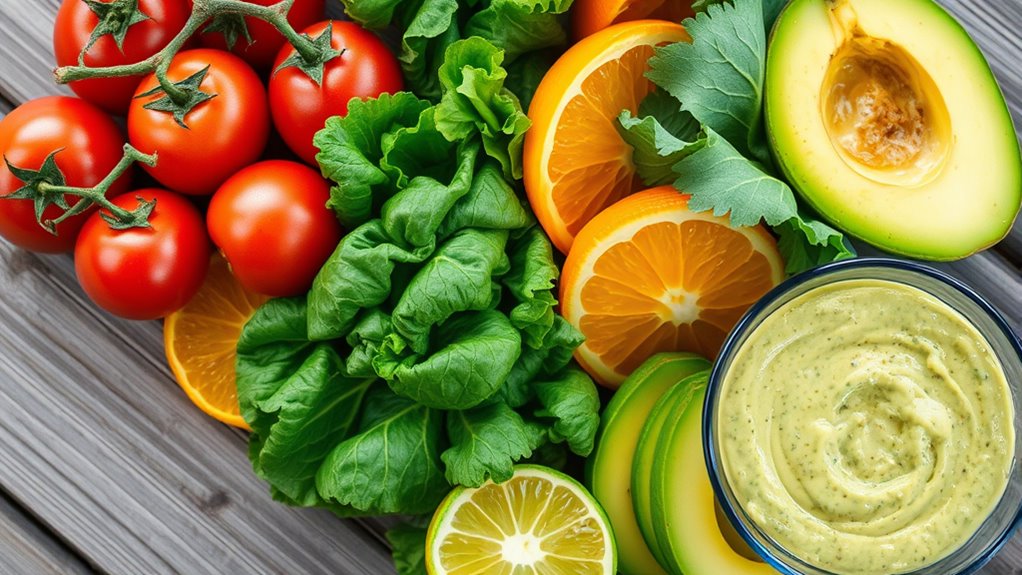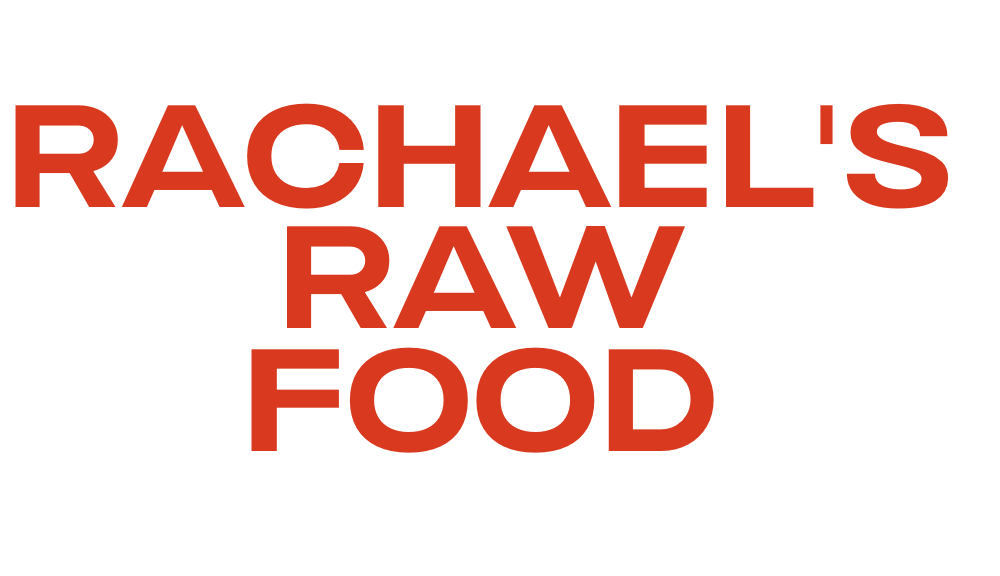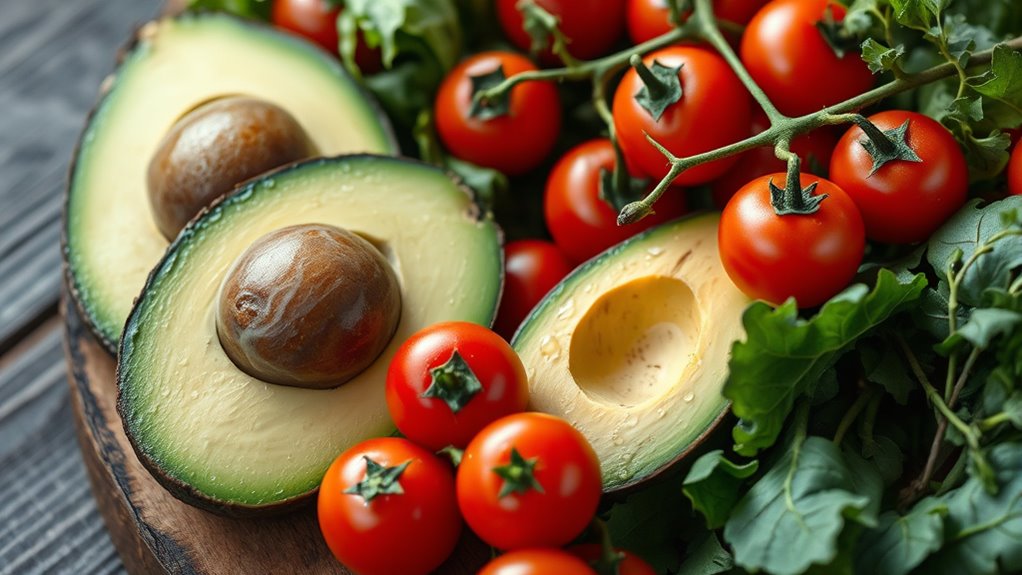If you’re curious about raw food, you’ll find that dehydration at low temperatures helps preserve nutrients and enzymes while creating crunchy snacks and extending shelf life. It’s important to guarantee proper safety by washing produce thoroughly and storing dehydrated foods in airtight containers. Although some heat-sensitive nutrients might degrade slightly, most remain intact, making raw food a healthy choice. Keep exploring to learn more tips and techniques for enjoying raw foods safely and deliciously.
Key Takeaways
- Proper dehydration at temperatures below 118°F preserves nutrients and enzymes in raw foods while preventing bacterial growth.
- Thoroughly wash produce and store dehydrated items in airtight containers to ensure raw food safety.
- Dehydrating extends shelf life and enhances variety without refrigeration, making raw diets more manageable.
- Some vitamins may degrade during dehydration; storing foods in cool, dark places helps retain nutritional value.
- Using a food-grade dehydrator and monitoring times and temperatures are essential for safe, high-quality raw snacks.

Are you curious about the benefits and challenges of eating raw food? If you’re exploring a raw diet, understanding how to prepare and preserve your meals is essential. Dehydrating techniques play a significant role here, allowing you to create crispy snacks and extend the shelf life of your favorite raw ingredients. Dehydration involves removing moisture from foods at low temperatures, usually below 118°F, which helps preserve nutrients and enzymes. This method not only adds variety to your raw food choices but also makes storage more manageable, especially when you’re making large batches of raw crackers, fruit leather, or veggie chips. However, while dehydrating can enhance your diet, it also raises questions about raw food safety. Because raw foods are not cooked at high temperatures, you need to be extra cautious to prevent bacterial growth and contamination. Making sure proper dehydration times and temperatures is essential to eliminate pathogens without compromising the raw integrity of your foods.
When it comes to raw food safety, you should always prioritize cleanliness. Wash all produce thoroughly to remove dirt, pesticides, and bacteria before dehydrating or consuming. Using food-grade dehydrators that maintain consistent temperatures helps make certain your foods are safe and free of harmful microorganisms. Be mindful that some raw foods, especially sprouts or certain dairy substitutes, carry higher risks of bacterial contamination. Incorporating proper handling and storage practices minimizes these risks and keeps your raw diet both enjoyable and safe. If you’re considering dehydrating foods for long-term storage, label your batches with dates and store them in airtight containers to prevent spoilage and pests. Remember, dehydration doesn’t kill all bacteria, so safe handling practices are indispensable throughout the process.
You might also wonder about the nutritional impact of dehydrating. While dehydration preserves most nutrients, some vitamins, like vitamin C and certain B vitamins, can degrade with exposure to air and light. To maximize nutritional retention, store dehydrated foods in cool, dark places and consume them within a reasonable timeframe. As you become more familiar with dehydration techniques, you’ll find that it’s an effective way to enjoy raw foods without relying on refrigeration or preservatives. Just make sure you’re attentive to raw food safety guidelines—this way, you can confidently enjoy your raw food journey without worry. Whether you’re making raw snacks or preparing ingredients for meals, mastering dehydrating techniques ensures you get the most out of your raw diet while keeping safety top of mind.
Frequently Asked Questions
Can Raw Food Help With Specific Health Conditions?
You might wonder if raw food benefits include helping with specific health conditions. Eating raw foods can support your health by providing enzymes and nutrients that aid digestion and boost immunity. For certain health conditions, incorporating raw foods may reduce inflammation or improve energy levels. While raw food benefits vary individually, many find that a balanced raw diet supports overall health and can complement other treatments. Always consult your healthcare provider for personalized advice.
What Are the Best Raw Snacks for On-The-Go?
You might think raw snacks aren’t filling enough, but with the right portable raw snacks, you’ll stay energized all day. Opt for raw snack ideas like trail mix, veggie sticks with dip, or energy balls packed with nuts and dried fruit. These options are easy to carry, healthy, and satisfy your cravings on the go. Keep a stash in your bag, and you’ll always have a nutritious, delicious snack ready whenever you need it.
How Do I Ensure Proper Nutrient Absorption Raw?
To guarantee proper nutrient absorption when eating raw foods, focus on smart food pairing and meal planning. Combine vitamin C-rich foods like citrus with iron-rich greens to boost absorption. Include healthy fats, such as avocado or nuts, to enhance fat-soluble vitamins. Avoid mixing calcium-rich foods with iron sources, which can hinder absorption. Thoughtful meal planning and strategic food pairing help your body maximize nutrients from raw foods efficiently.
Are Raw Foods Suitable for Children and Seniors?
Raw foods can be suitable for children and seniors if you carefully consider their unique needs. For pediatric nutrition, guarantee raw options are safe and nutrient-rich, avoiding choking hazards. For senior wellness, focus on easily digestible, nutrient-dense choices that support digestion and immunity. Always consult healthcare professionals to tailor raw food choices, making sure they complement overall health plans for both age groups.
What Equipment Is Essential for a Raw Food Diet?
Did you know that 80% of food safety issues come from improper handling? For a raw food diet, you need essential kitchen tools like sharp knives, a food processor, and a veggie scrub brush to keep everything clean and safe. These tools help you prepare ingredients efficiently, reduce contamination risks, and maintain freshness. Investing in quality kitchen tools guarantees you enjoy safe, delicious raw meals every time.
Conclusion
Now that you’ve explored these raw food questions, you’re better equipped to make informed choices. Did you know that a study found raw foods can retain up to 75% more nutrients than cooked ones? This highlights the potential health benefits of eating raw. So, whether you’re experimenting with raw recipes or just curious, embrace the vibrant, nutrient-rich world of raw foods—your body will thank you for it. Keep asking questions and stay curious on your journey!










